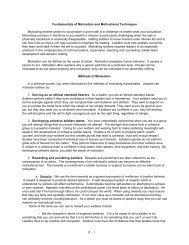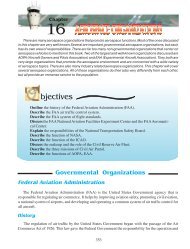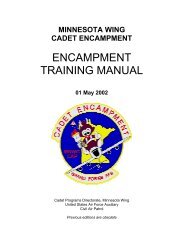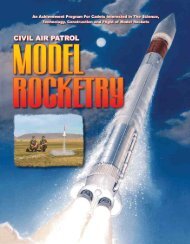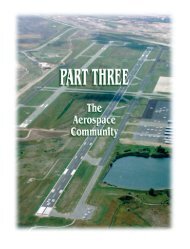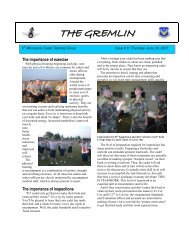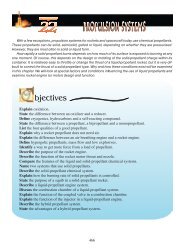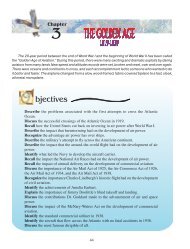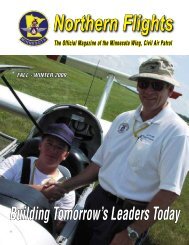paragraphs, Web pages, then edit and merge one another’scontributions. The knowledge capture (k-cap.org)and AI communities have studied building such KBs forover a decade. A well-known early attempt is openmind, 28which enlists volunteers to build a KB of commonsensefacts (for example, “the sky is blue”). Recently, the successof Wikipedia has inspired many “communitywikipedias,” such as Intellipedia (for the U.S. intelligencecommunity) and EcoliHub (at ecolicommunity.org, tocapture all information about the E. coli bacterium).Yet another popular target artifact is structured KBs. Forexample, the set of all Wikipedia infoboxes (that is, attribute-valuepairs such as city-name = Madison, state = WI)can be viewed as a structured KB collaboratively createdby Wikipedia users. Indeed, this KB has recently been extractedas DBpedia and used in several applications (seedbpedia.org). Freebase.com builds an open structureddatabase, where users can create and populate schemas todescribe topics of interest, and build collections of interlinkedtopics using a flexible graph model of data. As yetanother example, Google Fusion Tables (tables.googlelabs.com)lets users upload tabular data and collaborateon it by merging tables from different sources, commentingon data items, and sharing visualizations on the Web.Several recent academic projects have also studied buildingstructured KBs in a CS fashion. The IWP project35extracts structured data from the textual pages ofWikipedia, then asks users to verify the extraction accuracy.The Cimple/DBLife project 4,5 lets users correct theextracted structured data, expose it in wiki pages, thenadd even more textual and structured data. Thus, it buildsstructured “community wikipedias,” whose wiki pagesmix textual data with structured data (that comes from anunderlying structured KB). Other related works includeYAGONAGA, 11 BioPortal, 17 and many recent projects inthe Web, Semantic Web, and AI communities. 1,16,36In general, building a structured KB often requires selectinga set of data sources, extracting structured data fromthem, then integrating the data (for example, matchingand merging “David Smith” and “D.M. Smith”). Users canhelp these steps in two ways. First, they can improve theautomatic algorithms of the steps (if any), by editing theircode, creating more training data, 17 answering their questions12,13 or providing feedback on their output. 12,35 Second,users can manually participate in the steps. Forexample, they can manually add or remove data sources,extract or integrate structured data, or add even morestructured data, data not available in the current sourcesbut judged relevant. 5 In addition, a CS system may performinferences over its KB to infer more structured data.To help this step, users can contribute inference rules anddomain knowledge. 25 During all such activities, users cannaturally cross-edit and merge one another’s contributions,just like in those systems that build textual KBs.Another interesting target problem is building and improvingsystems running on the Web. The project WikiaSearch (search.wikia.com) lets users build an open sourcesearch engine, by contributing code, suggesting URLs tocrawl, and editing search result pages (for example, promotingor demoting URLs). Wikia Search was recentlydisbanded, but similar features (such as editing searchpages) appear in other search engines (such as Google,mahalo.com). Freebase lets users create custom browsingand search systems (deployed at Freebase), using thecommunity-curated data and a suite of development tools(such as the Metaweb query language and a hosted developmentenvironment). Eurekster.com lets users collaborativelybuild vertical search engines called swickis, bycustomizing a generic search engine (for example, specifyingall URLs the system should crawl). Finally, MOBS,an academic project, 12,13 studies how to collaborativelybuild data integration systems, those that provide a uniformquery interface to a set of data sources. MOBS enlistsusers to create a crucial system component, namelythe semantic mappings (for example, “location” = “address”)between the data sources.In general, users can help build and improve a systemrunning on the Web in several ways. First, they can editthe system’s code. Second, the system typically contains aset of internal components (such as URLs to crawl, semanticmappings), and users can help improve thesewithout even touching the system’s code (such as addingnew URLs, correcting mappings). Third, users can editsystem inputs and outputs. In the case of a search engine,for instance, users can suggest that if someone queries for“home equity loan for seniors,” the system should alsosuggest querying for “reverse mortgage.” Users can alsoedit search result pages (such as promoting and demotingURLs, as mentioned earlier). Finally, users can monitorthe running system and provide feedback.We note that besides software, KBs, and systems, manyother target artifacts have also been considered. Examplesinclude community newspapers built by asking usersto contribute and evaluate articles (such as Digg) andmassive multi-player games that build virtual artifacts(such as Second Life, a 3D virtual world partly built andmaintained by users).Executing Tasks: The last type of explicit systems we consideris the kind that executes tasks. Examples includefinding extraterrestrials, mining for gold, searching formissing people, 23,29,30,31 and cooperative debugging36
(cs.wisc.edu/cbi, early work of this project received theACM Doctoral Dissertation Award in 2005). The 2008election is a well-known example, where the Obama teamran a large online CS operation asking numerous volunteersto help mobilize voters. To apply CS to a task, wemust find task parts that can be “crowdsourced,” suchthat each user can make a contribution and the contributionsin turn can be combined to solve the parts. Findingsuch parts and combining user contributions are oftentask specific. Crowdsourcing the parts, however, can befairly general, and platforms have been developed to assistthat process. For example, Amazon’s MechanicalTurk can help distribute pieces of a task to a crowd ofusers (and several recent interesting toolkits have evenbeen developed for using Mechanical Turk 13,37 ). It wasused recently to search for Jim Gray, a database researcherlost at sea, by asking volunteers to examinepieces of satellite images for any sign of Jim Gray’s boat. 18Implicit Systems: As discussed earlier, such systems letusers collaborate implicitly to solve a problem of the systemowners. They fall into two groups: standalone andpiggyback.A standalone system provides a service such that whenusing it users implicitly collaborate (as a side effect) tosolve a problem. Many such systems exist, and the tablehere lists a few representative examples. The ESP game 32lets users play a game of guessing common words that describeimages (shown independently to each user), thenuses those words to label images. Google Image Labelerbuilds on this game, and many other “games with a purpose”exist. 33 Prediction markets 23,29 let users bet onevents (such as elections, sport events), then aggregatethe bets to make predictions. The intuition is that the“collective wisdom” is often accurate (under certain conditions)31 and that this helps incorporate inside informationavailable from users. The Internet Movie Database(IMDB) lets users import movies into private accounts(hosted by IMDB). It designed the accounts such thatusers are strongly motivated to rate the imported movies,as doing so bring many private benefits (such as they canquery to find all imported action movies rated at least7/10, or the system can recommend action movies highlyrated by people with similar taste). IMDB then aggregatesall private ratings to obtain a public rating for each movie,for the benefit of the public. reCAPTCHA asks users tosolve captchas to prove they are humans (to gain access toa site), then leverages the results for digitizing writtentext. 34 Finally, it can be argued that the target problem ofmany systems (that provide user services) is simply togrow a large community of users, for various reasons (suchas personal satisfaction, charging subscription fees, sellingads, selling the systems to other companies). Buy/sell/auction websites (such as eBay) and massive multiplayergames (such as World of Warcraft) for instance fitthis description. Here, by simply joining the system, userscan be viewed as implicitly collaborating to solve the targetproblem (of growing user communities).The second kind of implicit system we consider is a piggybacksystem that exploits the user traces of yet anothersystem (thus, making the users of this latter system implicitlycollaborate) to solve a problem. For example, overtime many piggyback CS systems have been built on topof major search engines, such as Google, Yahoo!, and Microsoft.These systems exploit the traces of search engineusers (such as search logs, user clicks) for a wide range oftasks (such as spelling correction, finding synonyms, fluepidemic prediction, and keyword generation for ads 6 ).Other examples include exploiting user purchases to recommendproducts, 26 and exploiting click logs to improvethe presentation of a Web site. 19CS SYSTEMS ON THE WEBWe now build on basic system types to discuss deployedCS systems on the Web. Founded on static HTML pages,the Web soon offered many interactive services. Someservices serve machines (such as DNS servers, GoogleMap API server), but most serve humans. Many suchservices do not need to recruit users (in the sense that themore the better). Examples include pay-parking-ticketservices (for city residents) and room-reservation services.(As noted, we call these crowd management systems).Many services, however, face CS challenges,including the need to grow large user bases. For example,online stores such as Amazon want a growing user basefor their services, to maximize profits, and startups suchas epinions.com grow their user bases for advertising.They started out as primitive CS systems, but quickly improvedover time with additional CS features (such as reviewing,rating, networking). Then around 2003, aided bythe proliferation of social software (for example, discussiongroups, wiki, blog), many full-fledged CS systems(such as Wikipedia, Flickr, YouTube, Facebook, MySpace)appeared, marking the arrival of Web 2.0. This Web isgrowing rapidly, with many new CS systems being developedand non-CS systems adding CS features.These CS systems often combine multiple basic CS features.For example, Wikipedia primarily builds a textualKB. But it also builds a structured KB (via infoboxes) andhosts many knowledge sharing forums (for example, discussiongroups). YouTube lets users both share and evaluatevideos. Community portals often combine all CSfeatures discussed so far. Finally, we note that the SemanticWeb, an ambitious attempt to add structure to the37
- Page 1 and 2: VOLUME FOUR STRATEGIC PERSPECTIVESL
- Page 3 and 4: VOLUME FOUR STRATEGIC PERSPECTIVESL
- Page 5 and 6: VOLUME FOUR STRATEGIC PERSPECTIVESL
- Page 7: VOLUME FOUR STRATEGIC PERSPECTIVESL
- Page 10 and 11: 12CHAPTER 12INTRODUCTION TO STRATEG
- Page 12 and 13: 12.1 Strategic Leadership: Defining
- Page 14 and 15: mandates or resolutions that would
- Page 16 and 17: and ambiguity, aspiring strategic l
- Page 18 and 19: 12.2 National Security StrategyThe
- Page 20 and 21: within our borders has always been
- Page 22 and 23: front common challenges like violen
- Page 24 and 25: and our strategy, not sector earmar
- Page 26 and 27: thinking about organizations. She m
- Page 28 and 29: A systemic approach to failure is m
- Page 30 and 31: The late W. T. Grant Company is a r
- Page 32 and 33: the resources - setting the directi
- Page 34 and 35: focal point for describing and inte
- Page 36 and 37: Consequently, we do not restrict th
- Page 40 and 41: Web, can be viewed as a CS attempt
- Page 42 and 43: How to evaluate users and contribut
- Page 44 and 45: 13CHAPTER 13LEADING PUBLIC &VOLUNTE
- Page 46 and 47: 13.1 Leadership for Volunteers:The
- Page 48 and 49: 13.2 Take Root: Volunteer Managemen
- Page 50 and 51: QualificationsClearly list educatio
- Page 52 and 53: and effectively track their volunte
- Page 54 and 55: • Understand rules for recognitio
- Page 56 and 57: • Send a birthday card.• Submit
- Page 58 and 59: and tested more than six decades af
- Page 60 and 61: specific interests of the donors, v
- Page 62 and 63: tain) tax-exempt status from the In
- Page 64 and 65: Smucker, 1999).The Internal Revenue
- Page 66 and 67: culture is necessary to ensure the
- Page 68 and 69: 13.4 The New Look of TransparencyBy
- Page 70 and 71: ees for a couple of reasons: One, i
- Page 72 and 73: 13.5 Public and Private Management:
- Page 74 and 75: TABLE 1:FUNCTIONS OF GENERAL MANAGE
- Page 76 and 77: 3. Career System. The model corpora
- Page 78 and 79: islative charter - the Clean Air Ac
- Page 80 and 81: In controlling performance, Chapin
- Page 82 and 83: 14CHAPTER 14AIRPOWER ASSTRATEGIC LA
- Page 84 and 85: 14.1 Strategic Air Power: Fulfillme
- Page 86 and 87: carry it out. Their daylight raids
- Page 88 and 89:
you did not rely on strategic bombi
- Page 90 and 91:
14.2 Warden and the Air Corps Tacti
- Page 92 and 93:
ecomes one of applying sufficient i
- Page 94 and 95:
tification, and a Jominian claim to
- Page 96 and 97:
courage the rapid and widespread ex
- Page 98 and 99:
it to influence physical players in
- Page 100 and 101:
14.4 Basic Air Force DoctrineAF Doc
- Page 102 and 103:
earthquake-stricken Haiti. The worl
- Page 104 and 105:
perspective. Airmen do not divide u
- Page 106 and 107:
Command and ControlCommand and cont
- Page 108 and 109:
14.5 Should the US Maintain the Nuc
- Page 110 and 111:
form of human government.” 20 Dem
- Page 112 and 113:
obtainable goal. See the Global Zer
- Page 114 and 115:
15CHAPTER 15ORGANIZATIONAL CULTURE
- Page 116 and 117:
15.1 Organizational CultureBy Doria
- Page 118 and 119:
Review. This action strives to unco
- Page 120 and 121:
gram will serve and then having the
- Page 122 and 123:
ticipating the changes being made b
- Page 124 and 125:
Many years of working with change p
- Page 126 and 127:
At the least, the areas of concern
- Page 128 and 129:
15.4 Developing an Innovative Cultu
- Page 130 and 131:
CONCLUDING THOUGHTSIn an ever-chang
- Page 132 and 133:
global issues. Businesses that poss
- Page 134 and 135:
— Sees the big picture—the shif
- Page 136 and 137:
16CHAPTER 16STRATEGIC COMMUNICATION
- Page 138 and 139:
16.1 Principles of Strategic Commun
- Page 140 and 141:
16.2 The Art of NegotiationBy Brend
- Page 142 and 143:
16.3 Negotiating Effectively Across
- Page 144 and 145:
hidden areas can act as cultural ho
- Page 146 and 147:
and four conflict styles. Hammer be
- Page 148 and 149:
maintaining the relationship. As th
- Page 150 and 151:
25 Mitchell R. Hammer, “Chapter 1
- Page 152 and 153:
tural, socioeconomic, and psycholog
- Page 154 and 155:
for the win-win," during which time
- Page 156 and 157:
interests and, at worst, as a gun s
- Page 158 and 159:
Public diplomacy is surely about mu
- Page 160 and 161:
But public diplomats do not have th
- Page 162 and 163:
Photo courtesy of the familyThe LEA
- Page 164:
THE CADET OATHI pledge that I will



